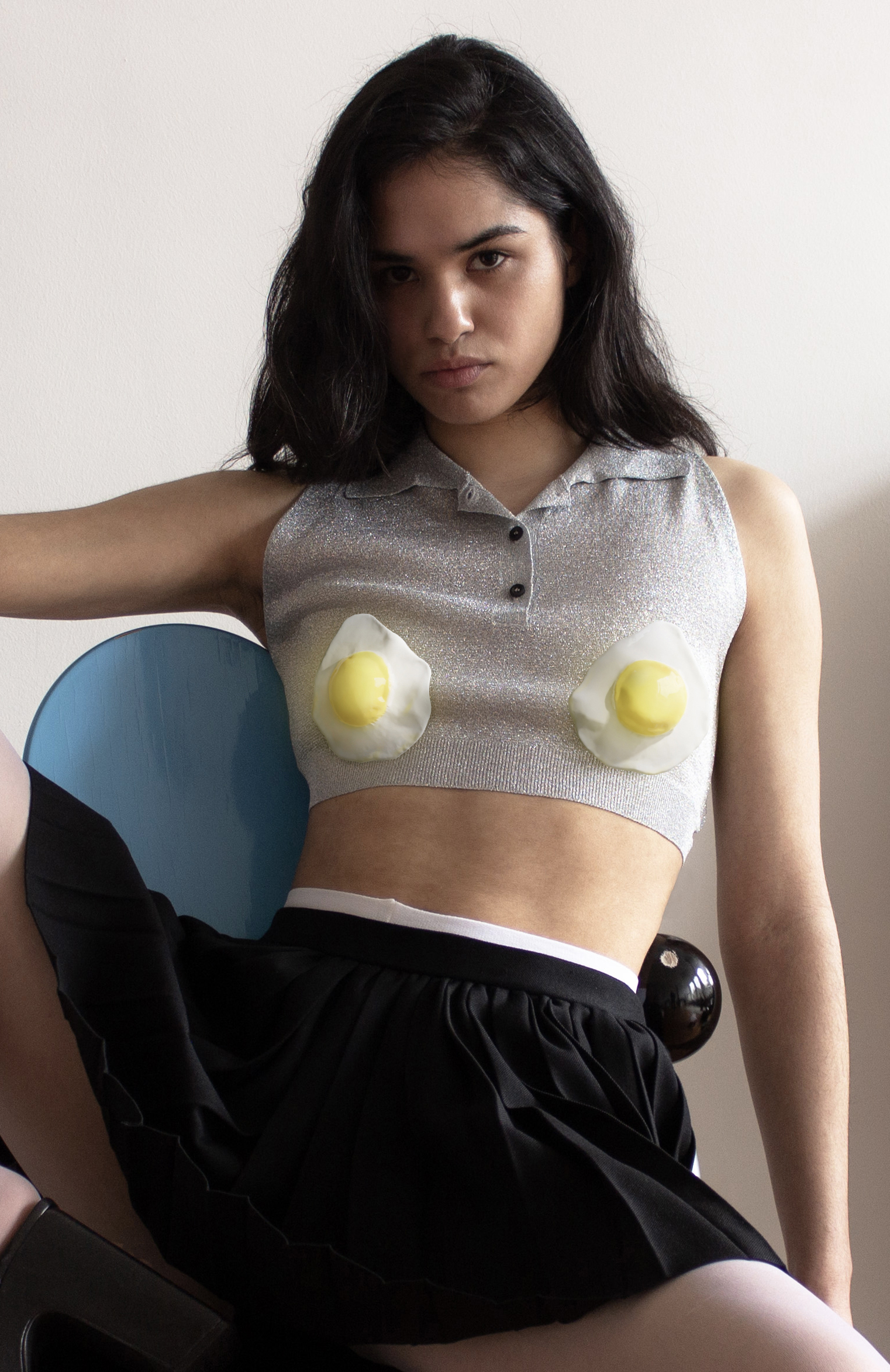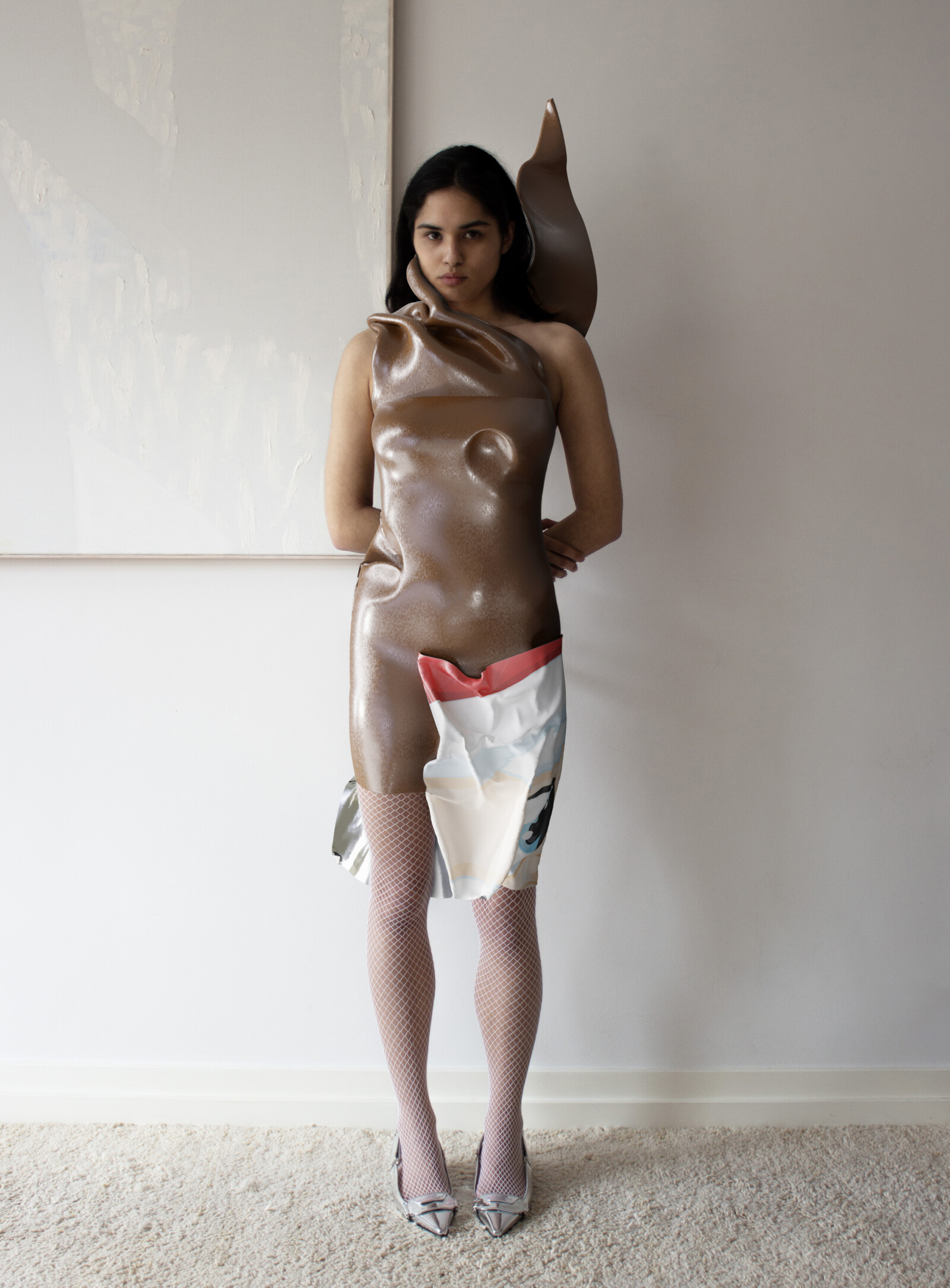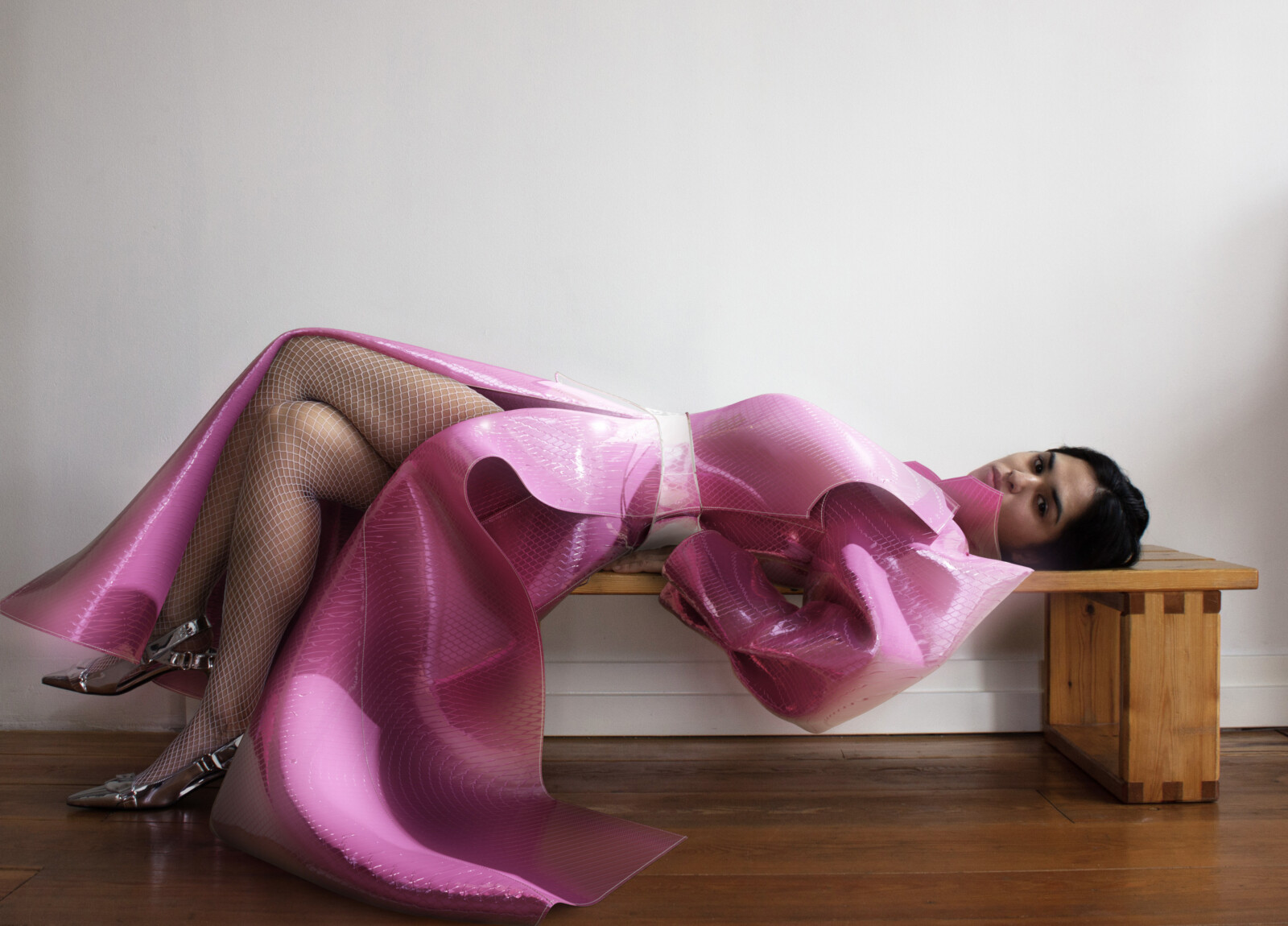

Ceci n'est pas
un œuf
byHannah van Well
Digital fashion – Tribute Brand
Words and images – Hannah van Well
An exploration of digital fashion in collaboration with Tribute Brand and why technology has the power to radically change the fashion system.
A while ago I shared an Instagram story where I was wearing a top with eggs. Within hours it was the most-watched and most-liked story I had ever shared. Never did I get so many DMs in 24 hours, with several people inquiring where I bought the top. They didn’t realize: those eggs that they were so hyped about did not actually exist. They were generated by AI, then placed carefully on my black cashmere top via AR (courtesy of Tribute Brand).
For the past two years, I have only told few people about my journey into (and obsession with) web3 – the next iteration of the internet. I was aware that most creatives I work with in the fashion industry aren’t the slightest bit interested in a digital revolution; many consider the idea of digital fashion to be cringe. I know this all too well because I used to be one of them. I hate the idea of an even more digital lifestyle than we already live. I love real life and what is traditionally considered ‘real’ fashion: clothes that you can wear, that you can touch, cherish, and hang in your closet. Vintage pieces that carry character and history. The brilliant designers and collections that shaped the rich history of fashion.
At the same time, working in the fashion industry always felt like contributing to a broken system. We’re all aware of the immense impact the fashion industry has on our planet. Yet despite many efforts from activists and even industry insiders, it seems impossible to slow down the system. Several brands have pledged to take steps towards more sustainable production. However, the only way to truly become more sustainable, is to simply produce and consume less. Because even a sustainably produced garment will eventually end up in a landfill. The result is an annoyingly complex paradox, as the industry relies on constant production of new products to remain relevant in our hyper fast society.


Alec Leach wrote a book about our hype culture called ‘The world is on fire, but we’re still buying shoes’. One quote in particular hit me: “Clothes in the hype era aren’t products to own, they’re moments to broadcast, to share on Instagram for 24 hours. They’re here, then they’re not. More like memes than products.” This made me think about the egg picture. If I owned a top with eggs, how often would I actually wear it? Maybe I’d wear it to some fashion event, I might even wear it to Christmas dinner to shock my family, but it would probably end up in the back of my closet. Instead, I have a simple top that I’ll wear endlessly – though I still got to have this viral moment on Instagram for 24 hours.
So, what’s new here? Most of us are already familiar with AR filters and digital fashion has been around for years – though mostly limited to some obscure influencers and gamers. What’s new, is that web3 – the internet built on blockchain technology – enables digital ownership: you can now own digital goods just like you can own things in the real world. This will radically transform the digital economy. More specifically: it has the potential to disrupt the fashion industry, because for the first time ever it is possible to monetize digital goods.
In a broader sense, web3 also refers to immersive virtual worlds. Rather than looking at screens all day, soon we’ll live in mixed reality where it will be harder to distinguish what’s real from what’s not. Does this sound like a creepy episode of Black Mirror or a slightly disturbing but fascinating world of new creative possibilities? I say the latter.
As the development of new technologies accelerates,
I’ve come to see this as an opportunity for the
fashion industry to transform. Radically.
I do realize that the idea of immersive virtual worlds – or (God forbid) the metaverse – has been hyped to an extent that it’s almost become a meme. So please don’t mistake me for saying that we should never leave our house again and live with a headset strapped to our face. The reality is much more nuanced: we already live in an early stage of the metaverse – a merging situation where our digital and physical lives increasingly overlap. Whether we like it or not, our digital presence became a crucial part of our social and professional lives. As the development of new technologies accelerates, I’ve come to see this as an opportunity for the fashion industry to transform. Radically. In the words of an AI-generated version of Julia Fox in Daniel Felstead’s short film on Dis: “The metaverse is not about creating some kind of separate, all-encompassing reality, that’s lame as f*ck and totally divorced from the real world. No honey, it’s about using it as a tool for creative experimentation to help us imagine new possibilities for the future.”
So here it comes: what if brands place a portion of their business exclusively online, only to be experienced in the virtual world? Could emerging technologies enable brands to realize (and monetize) their creative ideas in completely new ways, and can this finally slow down the production of physical collections?

For those unfamiliar with web3, this may sound like an overly ambitious statement. However, early adopters such as Nike and Gucci have proven that there is real money to be made in the metaverse. On top of that, their experimental first steps in this space show the potential to unlock creative innovation. Because I’m not just talking about digital clothes here – any digital object, collectible or experience can become part of our online identity. Prada’s first web3 project was a digital artwork, co-created by the crowd. I participated and will forever hold a small piece of Prada history in my digital wallet.
There is also a new generation of digital-first fashion brands emerging, such as Tribute Brand. Not only do they create chic virtual eggs and some of the best digital clothes; they are pioneering how fashion can be interpreted within different realities through experimenting with a wide range of new technologies. For their latest project, a collaboration with generative art project Chromie Squiggles, they use a computer coded algorithm to create one-of-a-kind knitted sweaters. Each sweater will carry an NFC chip that connects you to their app, enabling custom AR experiences. Collectors will also receive a digital blueprint of their sweater as well as a digital skin for virtual environments. Each piece will be handcrafted, made-to-order, and zero-waste through working with surplus yarns. Is your mind blown yet?
Emerging technologies are also a perfect tool to reconsider how new collections can be experienced. Balenciaga once created a virtual reality fashion show, that according to one Vogue editor was “completely mind-blowing”. When brands can develop a virtual experience that is as compelling as a real-life venue, flying the press to Marrakech for a 10-minute fashion show seems painfully outdated.
Ultimately, I believe it all boils down to redefining fashion and what it means to consume. New York-based cult brand Happy99 started exploring this topic in 2018 by designing virtual shoes that were intended only to be ‘consumed’ by the simple fact of being enjoyed online. It’s also about rethinking our perception of value – both in the digital and physical world. Thanks to blockchain technology, it’s possible to attribute real-world value to digital goods. At the same time, I believe that this may result in a newfound appreciation for physical items. Once our physical and digital lives increasingly overlap, it will be a more conscious decision to own something physically, or purely in digital form. Perhaps this will help us remember the true value (and true cost) of the clothes we own, which we seem to have lost sight of in our throwaway society.
We literally don’t need a place for anything to exist,
aside from in the images that we create.
Now for us image makers: we are in the perfect position to be early adopters if we want to drive change in our industry. Because for us, it doesn’t matter that virtual spaces don’t yet exist, and digital clothes cannot be worn anywhere. We literally don’t need a place for anything to exist, aside from in the images that we create. Once this starts to sink in, you realize that it totally makes sense to shoot a digital dress or to create work that’s (partially) AI-generated. The best part: it allows us to expand our artistic horizons, giving us a whole new category of mediums to experiment with. Plus: we seriously need to help shape the aesthetics of this new digital era, as I don’t think we should leave that to Mark Zuckerberg.
If emerging technologies can enable brands to tell their story in new ways that are wildly innovative and increasingly sustainable – I am here for it. What’s crucial here, is for fashion brands to have the balls to radically rethink their business models, rather than seeing this as an opportunity for a quick profit without any long-term vision. For an industry that is notoriously known for being obsessed with newness yet reluctant to truly change, this seems to be something worth fighting for.

Words & images – Hannah van Well
Street cast – Lisa Dymph Megens at Industry Art
Beauty – Laura Yard at NCL Representation
Model – Hannah Smith
Special thanks to Gala Marija Vrbanic and the Tribute Brand team, Merel Korteweg, Jhonathan Baena & Angelique Janssen